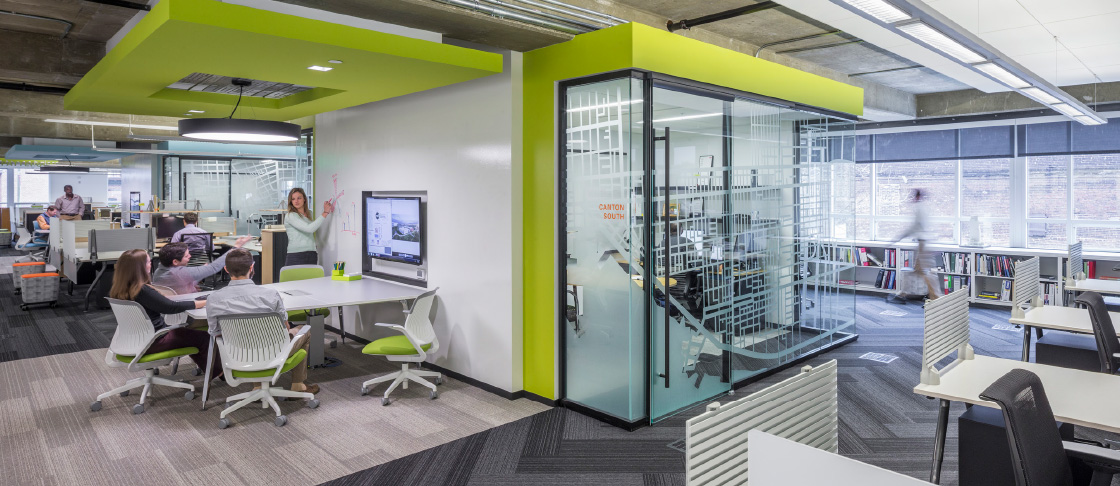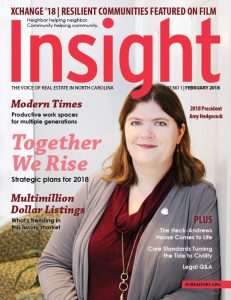Modern Times

 Designing spaces for multiple generations
Designing spaces for multiple generations
BY: TRACEY GOULD
For the first time in history, five generations are working alongside each other—millennials, GenX, Gen Y, baby boomers and traditionalists. The “office”—and other spaces—are rapidly adjusting to accommodate varying work and lifestyles. It’s no longer a one-size-fits-all solution.
Multigenerational design—a trending but critical design strategy that explores spaces for the way we live and interact with one another—analyzes how generations relate, coexist and function in different environments. And this isn’t just about the office, either. Scott Delano, design director for Wright Heerema Architects, stated this intentional design concept “applies to how we work, play, sleep, learn and eat—all of it.”
CallisonRTKL’s Associate Vice President Jodi Williams, AICP, LEED AP BD+C, refers to the design strategy as speaking “to the core value for designing for inclusion, including physical and mental abilities, age and more. It’s about designing spaces that accommodate the people that need to use them and give them the comfort level to succeed.” CallisonRTKL, a global architecture, planning and design firm, designs each project with inclusion of all users in mind, starting with an intensive charrette process up front. They focus on working within their own talents and skills to make sure they ask all the right questions for every project up front, using design thinking to solve problems (operational, functional, design, performance, communication, and otherwise). “If we’re not asking the right questions from the beginning, we’re automatically excluding some demographics and end users of the space,” stated Williams.
Not too long ago, architecture and interior design was largely based on baby boomers and how they worked. This generation, as Delano describes, was successfully rooted in more structured spaces—booths, cubes, corner offices. This was the generation that defined professional success by their office type. A corner office with a window and a nice view meant “I’ve arrived.” Other generations started entering a boomer-centric physical environment, including GenX and GenY, and had to adapt to a more traditional space. It wasn’t until millennials entered the work force, Delano quipped, that owners, architects and designers were forced to rethink design and how people worked within different spaces. GenX wasn’t a large enough group to exert any force or influence on broad design trends, but millennials are now fast approaching 50 percent of the workforce. Owners and designers are quickly taking notice.
Ultimately, the goal behind multigenerational design is to look at how each group defines success, according to Delano, “and it’s not the corner office. We’re trying to find the spaces that make that path for them.” For millennials, “making it” is defined very different from generations before them. It equates to collecting life experiences to inform them that they are doing well, “so we’re looking at the new work environment to provide meaningful opportunities for success.” This isn’t to say prior generations didn’t want to have meaningful life experiences. They did—it just wasn’t their main focus.
Everyone wants to connect to something, especially considering the proliferation of technology today. “Tools such as smartphones, Facebook and Skype are great connectors and artifices that provide an alternate reality, which connects you to things and ideas, but not with people,” stated Delano. “Even with FaceTime, we’re sort of connected to people, but it’s not the same. We crave interaction and things that are real.”
Mutigenerational design isn’t only end user centric. It also is focused on organizational goals and objectives, such as supporting sales and efficiencies. “It’s about getting the highest and best uses out of each space,” says Delano.
Ultimately owners and businesses need to get to the root of what their organizational needs are. “This includes all elements of the organization—not just the dividers—and design to what those requirements are and what the future anticipated needs are based on the information gathered to date,” stated Williams. CallisonRTKL encourages clients to constantly seek feedback from their employees and users of their space, and revisit floorplans, adjacencies, furniture, technology and other components every 18 months to understand what is and isn’t working due to functional changes. Companies should be flexible and open to change.
Overall, it’s a strong business decision to make the modern office attractive, functional and efficient for all demographics. Creating productive environments with no barriers to work, while providing a space that is supportive of end user requirements, just makes business sense.
At Work in NC
McIlveen Family Law challenged traditional office design with an open concept floorplan that fits its multigenerational staff perfectly. For an operational law firm with traditional roots, this was quite the adjustment for existing employees and for prospective employees coming from traditional law firm office environments. Their new floorplan, which has been adapted to each of their locations in Gastonia, Charlotte and Raleigh, ditched closed offices and cubicles for open seating. This was important to the founding partners, knowing there are four generations working side-by-side in the practice.
Lawyers no longer have dedicated office space, which was a decision that was difficult for some to accept at first. However, when Angela McIlveen, partner attorney, surveyed the lawyers and asked them to track the number of hours they actually spent in their offices, the lawyers were surprised by the fact that none of them spent more than five hours per week in the office. They were either meeting with clients in conference rooms or off-site handling cases. Suddenly, an open office concept seemed more logical—and less intimidating.
The result for McIlveen is that lawyers, paralegals, marketing and other support staff work next to each other—even the partner attorneys. Chris Culp, managing attorney and director of legal operations, as well as the oldest person in his office, stated, “In the traditional workspace, you tend to get isolated. While easier to concentrate and work on discreet projects, you don’t get the benefit to learn by observing others. This knowledge sharing doesn’t happen in traditional office environments.”
Active eavesdropping—to listen to people discuss a case that may be similar to yours—can rapidly increase the learning curve, Culp stated. In the standard law office environment, lawyers and other staff had to knock on office doors and call or email multiple people to inquire if they had relevant experience and could answer a question. This took hours or sometimes days to get the information needed. Younger attorneys no longer rely only on the partners as a mentor—it’s more organic office-wide.
EFFICIENCY AND COST SAVINGS. For McIlveen, the cost savings is outstanding. No longer is there unused office space. Offices that are dark four out of five days are gone, as are unused hallways. In place of those spaces are active and engaging shared areas, which are conducive to team building and recruitment.
RECRUITING AND RETENTION. Culp states their new offices at McIIveen demonstrate their innovative culture, which aligns more with younger generations that tend to congregate and work in groups. Interviewees, who experience the front- and back-of-house spaces, “are drawn to the energy in the space. They see a lot of activity, but it’s so different. You get the feeling there’s a lot of communication and collaboration happening, which is contrary to the vibe in most attorney offices.”
Unique spaces and features in progressive office spaces, like kegerators, free food and beverages, rooftop work and relaxation spaces with Wi-Fi and reading nooks and nap rooms, make recruiting for open office environments much easier than it used to be—even for the traditionalists. Likewise, retention is much higher provided other personal and professional needs are being met.
Culp admits their non-traditional legal office environment, which just went paperless, isn’t for everyone. There are still people who measure success with a corner office in a high-rise, and for open office environments, those values don’t align well.

